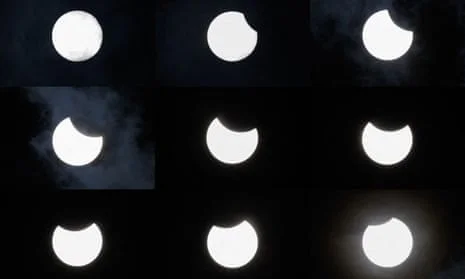
Partial Solar Eclipse Captivates Northern Hemisphere
A partial solar eclipse graced the skies of the Northern Hemisphere on March 29, 2025, captivating skywatchers from various locations. The event, which saw the moon partially blocking the sun, was visible across North America, Europe, and parts of Asia. Enthusiasts gathered to witness the celestial phenomenon, sharing stunning images and live updates on social media platforms.
The eclipse's visibility varied by location, with some areas experiencing a more significant obscuration of the sun. Forbes provided a comprehensive guide on upcoming solar eclipses, highlighting future viewing opportunities and optimal locations. Axios reported on the unique occurrence of a double sunrise, adding to the spectacle of the day. The Guardian offered live coverage, including real-time images and updates, ensuring that those unable to view the eclipse in person could still experience its beauty.
Astronomy enthusiasts are encouraged to prepare for the next eclipse events, as detailed by Space.com, which offered insights on how, where, and when to view future eclipses. The partial solar eclipse of March 2025 served as a reminder of the wonders of our universe and the importance of celestial events in bringing people together in awe and appreciation.
Related issues news
What is a partial solar eclipse?
A partial solar eclipse occurs when the moon passes between the Earth and the sun, partially blocking out the sun's light. By contrast, in a total solar eclipse the moon completely blocks the sun's light.
How to watch the partial solar eclipse?
View the Sun through eclipse glasses or a handheld solar viewer during the partial eclipse phases before and after totality. You can view the eclipse directly without proper eye protection only when the Moon completely obscures the Sun's bright face – during the brief and spectacular period known as totality.
When is there a solar eclipse in 2025?
On March 29, 2025, only some of the Sun will be covered by the Moon. It will be a partial solar eclipse. It will look like the Moon is taking an ever-increasing bite out of the Sun, but the Moon won't cover the Sun completely. What's more, not everyone in the USA and Canada will get to see it.
Can you look at a partial solar eclipse?
Even during a partial eclipse, it is never safe to look directly at the Sun with the naked eye as it can cause eye damage, including blindness. Solar eclipse glasses are specifically designed to filter out harmful UV rays and reduce the intense brightness of the Sun, making it safe to look directly at the eclipse.